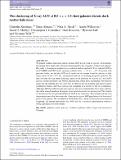Files in this item
The clustering of X-ray AGN at 0.5 < z < 4.5 : host galaxies dictate dark matter halo mass
Item metadata
| dc.contributor.author | Krishnan, Charutha | |
| dc.contributor.author | Almaini, Omar | |
| dc.contributor.author | Hatch, Nina A. | |
| dc.contributor.author | Wilkinson, Aaron | |
| dc.contributor.author | Maltby, David T. | |
| dc.contributor.author | Conselice, Christopher J. | |
| dc.contributor.author | Kocevski, Dale | |
| dc.contributor.author | Suh, Hyewon | |
| dc.contributor.author | Wild, Vivienne | |
| dc.date.accessioned | 2020-09-07T16:30:01Z | |
| dc.date.available | 2020-09-07T16:30:01Z | |
| dc.date.issued | 2020-05 | |
| dc.identifier | 269755709 | |
| dc.identifier | c4504ae3-951f-489c-b9ab-23a42839e61a | |
| dc.identifier | 000535877200012 | |
| dc.identifier | 85087974470 | |
| dc.identifier.citation | Krishnan , C , Almaini , O , Hatch , N A , Wilkinson , A , Maltby , D T , Conselice , C J , Kocevski , D , Suh , H & Wild , V 2020 , ' The clustering of X-ray AGN at 0.5 < z < 4.5 : host galaxies dictate dark matter halo mass ' , Monthly Notices of the Royal Astronomical Society , vol. 494 , no. 2 , pp. 1693-1704 . https://doi.org/10.1093/mnras/staa815 | en |
| dc.identifier.issn | 0035-8711 | |
| dc.identifier.other | BibCode: 2020MNRAS.494.1693K | |
| dc.identifier.uri | https://hdl.handle.net/10023/20578 | |
| dc.description.abstract | We present evidence that active galactic nuclei (AGN) do not reside in 'special' environments, but instead show large-scale clustering determined by the properties of their host galaxies. Our study is based on an angular cross-correlation analysis applied to X-ray selected AGN in the COSMOS and UDS fields, spanning redshifts from z ∼ 4.5 to z ∼ 0.5. Consistent with previous studies, we find that AGN at all epochs are on average hosted by galaxies in dark matter haloes of 1012-1013 M⊙, intermediate between star-forming and passive galaxies. We find, however, that the same clustering signal can be produced by inactive (I.e. non-AGN) galaxies closely matched to the AGN in spectral class, stellar mass, and redshift. We therefore argue that the inferred bias for AGN lies in between the star-forming and passive galaxy populations because AGN host galaxies are comprised of a mixture of the two populations. Although AGN hosted by higher mass galaxies are more clustered than lower mass galaxies, this stellar mass dependence disappears when passive host galaxies are removed. The strength of clustering is also largely independent of AGN X-ray luminosity. We conclude that the most important property that determines the clustering in a given AGN population is the fraction of passive host galaxies. We also infer that AGN luminosity is likely not driven by environmental triggering, and further hypothesize that AGN may be a stochastic phenomenon without a strong dependence onenvironment. | |
| dc.format.extent | 12 | |
| dc.format.extent | 1739310 | |
| dc.language.iso | eng | |
| dc.relation.ispartof | Monthly Notices of the Royal Astronomical Society | en |
| dc.subject | Galaxies: active | en |
| dc.subject | Galaxies: evolution | en |
| dc.subject | Galaxies: haloes | en |
| dc.subject | Large-scale structure of Universe | en |
| dc.subject | QB Astronomy | en |
| dc.subject | QC Physics | en |
| dc.subject | 3rd-DAS | en |
| dc.subject.lcc | QB | en |
| dc.subject.lcc | QC | en |
| dc.title | The clustering of X-ray AGN at 0.5 < z < 4.5 : host galaxies dictate dark matter halo mass | en |
| dc.type | Journal article | en |
| dc.contributor.institution | University of St Andrews. School of Physics and Astronomy | en |
| dc.identifier.doi | 10.1093/mnras/staa815 | |
| dc.description.status | Peer reviewed | en |
| dc.identifier.url | https://arxiv.org/abs/2003.10461 | en |
| dc.identifier.url | http://adsabs.harvard.edu/abs/2020MNRAS.494.1693K | en |
This item appears in the following Collection(s)
Items in the St Andrews Research Repository are protected by copyright, with all rights reserved, unless otherwise indicated.

